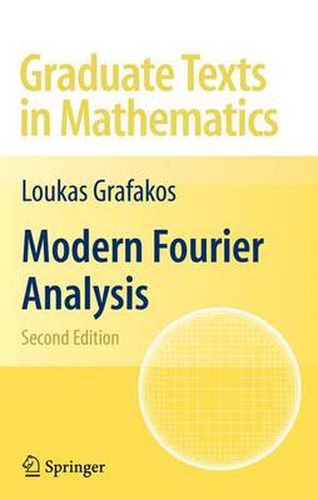Readings Newsletter
Become a Readings Member to make your shopping experience even easier.
Sign in or sign up for free!
You’re not far away from qualifying for FREE standard shipping within Australia
You’ve qualified for FREE standard shipping within Australia
The cart is loading…






This title is printed to order. This book may have been self-published. If so, we cannot guarantee the quality of the content. In the main most books will have gone through the editing process however some may not. We therefore suggest that you be aware of this before ordering this book. If in doubt check either the author or publisher’s details as we are unable to accept any returns unless they are faulty. Please contact us if you have any questions.
The great response to the publication of the book Classical and Modern Fourier Analysishasbeenverygratifying.IamdelightedthatSpringerhasofferedtopublish the second edition of this book in two volumes: Classical Fourier Analysis, 2nd Edition, and Modern Fourier Analysis, 2nd Edition. These volumes are mainly addressed to graduate students who wish to study Fourier analysis. This second volume is intended to serve as a text for a seco- semester course in the subject. It is designed to be a continuation of the rst v- ume. Chapters 1-5 in the rst volume contain Lebesgue spaces, Lorentz spaces and interpolation, maximal functions, Fourier transforms and distributions, an introd- tion to Fourier analysis on the n-torus, singular integrals of convolution type, and Littlewood-Paley theory. Armed with the knowledgeof this material, in this volume,the reader encounters more advanced topics in Fourier analysis whose development has led to important theorems. These theorems are proved in great detail and their proofs are organized to present the ow of ideas. The exercises at the end of each section enrich the material of the corresponding section and provide an opportunity to develop ad- tional intuition and deeper comprehension. The historical notes in each chapter are intended to provide an account of past research but also to suggest directions for further investigation. The auxiliary results referred to the appendix can be located in the rst volume.
$9.00 standard shipping within Australia
FREE standard shipping within Australia for orders over $100.00
Express & International shipping calculated at checkout
This title is printed to order. This book may have been self-published. If so, we cannot guarantee the quality of the content. In the main most books will have gone through the editing process however some may not. We therefore suggest that you be aware of this before ordering this book. If in doubt check either the author or publisher’s details as we are unable to accept any returns unless they are faulty. Please contact us if you have any questions.
The great response to the publication of the book Classical and Modern Fourier Analysishasbeenverygratifying.IamdelightedthatSpringerhasofferedtopublish the second edition of this book in two volumes: Classical Fourier Analysis, 2nd Edition, and Modern Fourier Analysis, 2nd Edition. These volumes are mainly addressed to graduate students who wish to study Fourier analysis. This second volume is intended to serve as a text for a seco- semester course in the subject. It is designed to be a continuation of the rst v- ume. Chapters 1-5 in the rst volume contain Lebesgue spaces, Lorentz spaces and interpolation, maximal functions, Fourier transforms and distributions, an introd- tion to Fourier analysis on the n-torus, singular integrals of convolution type, and Littlewood-Paley theory. Armed with the knowledgeof this material, in this volume,the reader encounters more advanced topics in Fourier analysis whose development has led to important theorems. These theorems are proved in great detail and their proofs are organized to present the ow of ideas. The exercises at the end of each section enrich the material of the corresponding section and provide an opportunity to develop ad- tional intuition and deeper comprehension. The historical notes in each chapter are intended to provide an account of past research but also to suggest directions for further investigation. The auxiliary results referred to the appendix can be located in the rst volume.